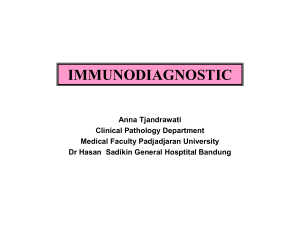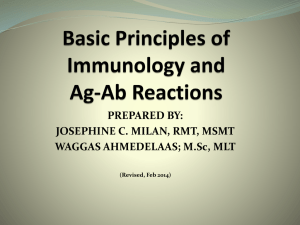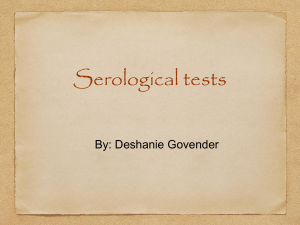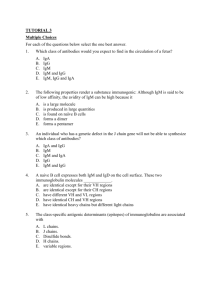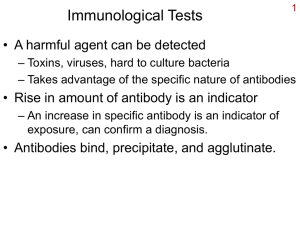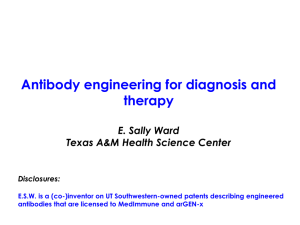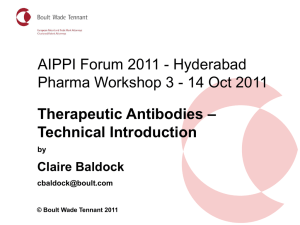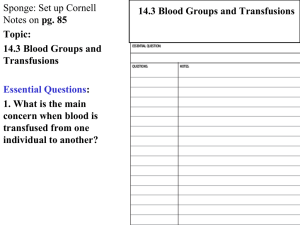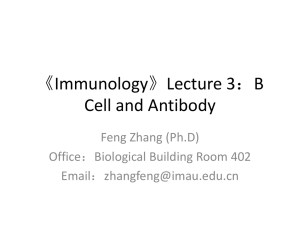ViewBasics_of_immunohematology
advertisement
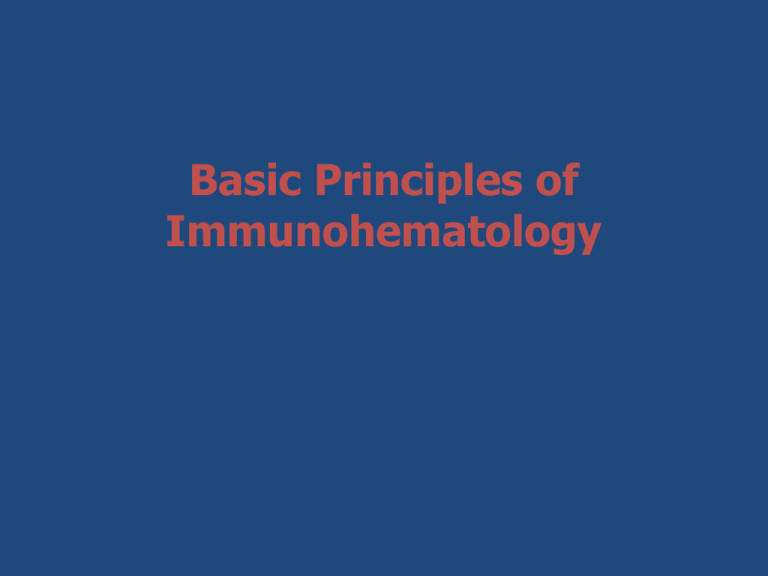
Basic Principles of Immunohematology Teaching Aims • To understand the basis of Immunology and genetics which are closely involved in the understanding of blood group serology Antigen and Antibody • Antigen: A substance that on introduction give rise to a formation of antibody that reacts specifically with the same antigenic substance. Antibody: A gamma-globulin product of an immune response, (also called immunoglobulin) that reacts with antigen against which it is stimulated. Characteristics of antigen • Chemical structure of antigen – Antigens composed of oligosaccharides tend to stimulate IgM type of antibody production – Antigens which are primarily protein in nature, produce IgG antibody • Degree of foreignness • Number of antigens introduced – Higher the dose, greater the antibody production • Route of administration – Intramuscular or subcutaneous route more potent Immunogenicity • Ability of an antigen to stimulate the production of its corresponding antibody in a person who lacks the antigen • Rh D most potent antigenic • Fya is poor antigenic Immunogenicity of antigens Antigens D C c E e K k Fya Jka Jkb S s System Rh Kell Duffy Kidd MNS Immunogenicity (%) 70 0.2 04 3.3 1.1 10 1.5 0.6 0.1 0.03 0.08 0.06 Immunoglobulins Five types, viz. IgG, IgM, IgA, IgD & IgE. Blood group antibodies are mainly confined to IgG & IgM. IgG is a smaller molecule, with a pair each of heavy & light chains of amino acids. IgG antibody can just coat but not agglutinate the cells. IgM has 5 such pairs joined together by the J chain. IgM antibody agglutinate the cells bearing corresponding antigen. Properties of human immunoglobulins Properties IgG IgM IgA Gamma Mu Alpha 1000 – 1500 85 - 205 200 - 350 150,000 900,000 180,000 Occasionally Yes No Monomer Pentamer Mono / diamer Crosses placenta Yes No No Secretions No No Yes H chain, Class Serum conc (mg/dl) Molecular weight Complement fixation Structure IgM Antibodies (Complete) • Agglutinate in saline phase • Pentavalent • Usually naturally occurring • Do not cross placenta • React at temperature varying from 4 – 20oC • Example: ABO antibodies IgG Antibodies (Incomplete) • Agglutinate in IAT phase • However, may cause agglutination in saline phase using albumin / enzymes • Monovalent • Usually immune in nature • Can cross placenta • React at 37oC • Example: Rh antibodies 14 nm 35 nm IgG IgM 24 nm Intracellular distance Complete and Incomplete antibody Complete antibody -IgM Incomplete antibody -IgG Antibody (Immune) Response IgG IgM Naturally occurring Vs Immune Antibodies Feature Naturally occurring Immune Antigen stimulus Obscure, possibly from microbial origin IgM Human red cell antigens IgG < 22o C at 37o C Acute HTR HDN, DHTR ABO antibodies Rh, Kell, Kidd, Duffy antibodies Type of Immunoglobulin Optimum temperature Clinical significance Examples Clinical Significance of Antibody Clinically significant • • • • • • ABO Rh Kell Duffy Kidd Ss Clinically insignificant • • • • • Lewis M,N P1 Lutheran A1 Types of Antigen-Antibody Reactions Agglutination Sensitization Haemolysis Neutralization (inhibition) Precipitation Immunofluorescence Complement fixation Radio Immunoassay Antigen-Antibody Reaction Stages of ag-ab reaction Stage of sensitization • Only coating of red cells with IgG antibody without causing agglutination • Bond holding ag-ab complex may dissociate & re-associate till the state of equilibrium is reached Stage of agglutination • Characterized by formation of bridges between sensitized red cells resulting in visible aggregate of red cells Factors affecting stage of sensitization • Antigen – Antibody ratio – Two volume of serum and one volume of 5% red cells – Sensitivity of test depends upon number of antibody molecules bound per red cells • pH – Most antibodies detected at neutral pH • Temperature – IgM antibodies react optimally at cold temp while IgG at 37oC • Incubation time – Time needed to reach ag-ab reaction at equilibrium – Too short incubation – weaker reaction – Prolonged incubation results in dissociation of antibody Factors affecting stage of agglutination • Size & Class of antibody – IgM antibody, being a pentamer can bind antigen sites up to 35 nm apart – IgG antibody, being a monomer can bind antigen sites up to 14 nm apart • Antigenic sites – Antigens located on surface of red cell membrane (ABO) result in strong agglutination – Antigens embedded in membrane (Rh antiges) result in weaker agglutination • Zeta potential – Electrostatic repulsive force between red ells Electron Cloud Around Each Cell zeta potential Effect of adding LISS Reduction in zeta potential using LISS RBCs come closer together Strong agglutination Reduction in incubation time Red Cell Serological Techniques ABO and Rh (D) typing Weak ‘D’ or Du testing Antibody screening & identification Pre-transfusion testing Indirect antiglobulin test Direct antiglobulin test Genetics: Basics • Gene – A biological unit of inheritance – Dominant gene – always expressed as antigen regardless of whether it is in homozygous or heterozygous state – Recessive gene – produce antigen only when in homozygous state • Chromosome – Linear arrangement of genes • Locus – Hypothetical seat of gene on a chromosome • Allele – Al alternative form of gene at particular locus Genetics: Basics • Genotype – Sum total of genes present on chromosome regardless of whether or not they produce detectable products. – Determined through testing of genes & family study • Phenotype – Detectable products (antigens) demonstrated through direct testing only Genotype Vs Phenotype Phenotype Genotype A1 A1A1 A1A2 A1O A2 A2A2 A2O B BB BO O OO Genetics: Basics • Homozygous: – presence of identical pair of allelic genes on both chromosomes – double dose of antigens – stronger reaction with corresponding antibody – example: KK • Heterzygous: – different alleles of genes on pair of chromosome – weaker reaction with corresponding antibody – example: Kk Learning Outcomes • You will now understand the basic immunology and genetics related to blood banking


